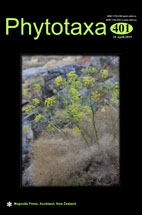Abstract
The genus Amphora sensu lato was considered highly heterogeneous for a long time. Modern microscopy and molecular analyses revealed significant differences in cell morphology and structure, thus suggesting polyphyly of the genus. New findings resulted in separation and description of several amphoroid genera. Recently, the genus Tetramphora Mereschkowsky was re-established based on ultrastructural and molecular analyses. The genus is widely spread in marine and brackish habitats. Recent observations of contemporary flora and cores from Lake Vransko (Croatia) revealed a new species of Tetramphora. The new species is characterized by having large semi-elliptical valves with arched dorsal margin and biarcuate ventral margin, length of 49.0–78.0 µm and width between 7.5–12.0 µm. The raphe is discontinuous, with proximal raphe ends externally covered with large siliceous flap. Striae are uniseriate, composed of small round to elongated areolae. Based on this unique combination of characters visible on light and scanning electron microscope, a new species Tetramphora croatica sp. nov. is described.

